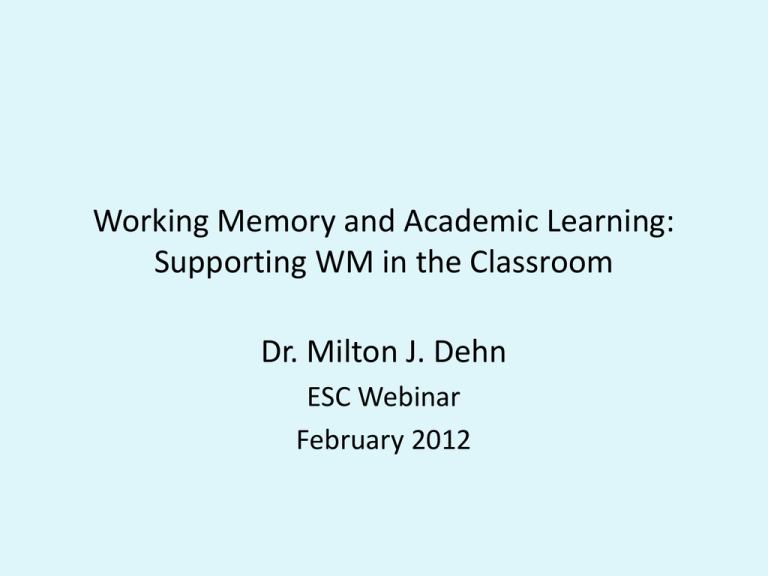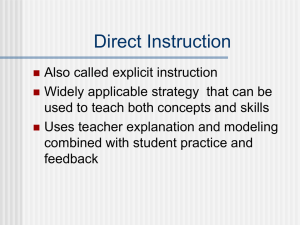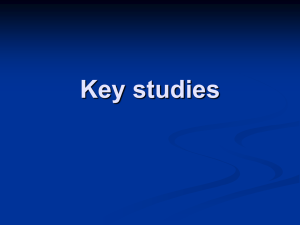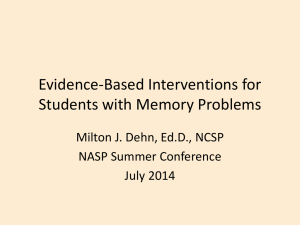
Working Memory and Academic Learning:
Supporting WM in the Classroom
Dr. Milton J. Dehn
ESC Webinar
February 2012
Notice of Copyright, 2012
This PowerPoint and accompanying materials
are copyrighted by Milton J. Dehn and
Schoolhouse Educational Services, LLC. All
rights reserved. No photocopying, electronic
display, or electronic dissemination of these
materials is allowed without written
permission.
Workshop Information Sources
• References in handouts
• Dehn, M. J. (2008). Working Memory and
Academic Learning: Assessment and
Intervention. Wiley: 2008.
• Dehn, M. J. (2011). Helping Students
Remember
• Presenter Contact Info.
Milton J. Dehn: cpps@psychprocesses.com
WM Workshop Content
1.
2.
3.
4.
5.
6.
7.
8.
9.
10.
WM screening
WM and academic learning
WM and LD
Cognitive load
Working memory and specific academic skills
Classroom instruction that reduces WM load
Mnemonic classroom
WM strategies
Accommodations
LTM strategies that support WM
Working Memory Screening for
Young Children
1. Verbal: Digits Forward; Letter Span; Memory
for Words; Memory for Sentences
2. Visual-spatial: Picture Recognition, Spatial
Span, Recall of Designs
3. Executive WM: Digits Backward; LetterNumber
4. WM levels are very predictive of later
academic performance; need for LD
WM Deficits and Academic Skills
• Of children with WM abilities in the bottom
10 percentiles, over 80% have substantial
problems in either reading or math, or most
commonly both (Gathercole)
• Their academic learning is frequently hindered
by WM overload
Children’s WM in the Classroom
1. In the average class, WM capacity will range
5 years of WM development
2. Those with WM deficits have slower rates of
learning
3. Most activities require keeping info. in mind
while cognitively processing
4. WM deficits often mistaken for attention
and motivation problems
WM and Learning
1. WM capacity is a general limiting factor for
academic learning; specifically, it is necessary
for the generation and modification of
knowledge stored in LTM
2. Direct access and maintenance of several
separate elements is necessary to construct
new relations in episodic WM and LTM
3. Also necessary for successful academic
performance
WM and Academic Learning
1.
2.
3.
4.
A core cognitive process
WM predicts academic learning
Deficit predicts need for special ed.
One in 10 children has a WM impairment
(Alloway)
5. Perhaps half of LD have a WM deficit (Dehn)
6. WM deficits seen in several disabilities
Populations with WM Deficits
1.
2.
3.
4.
5.
LD
ADHD, especially inattentive type
TBI
Down’s Syndrome
Language Impaired
RD WM Deficits: WISC-IV Means
Perceptual Reasoning
94.4
Processing Speed
92.5
Verbal Comprehension
91.9
Working Memory
87.0
LD WM Deficits
1. Comorbid disabilities
1. Involve executive WM
2. A broader impairment of W
2.
3.
4.
5.
6.
Capacity or strategy deficit?---capacity for LD
But they also lack strategy use (catch 22)
LTM/knowledge makes a difference
So how do they learn?---under low load conditions
Other processing deficits also reduce WM span,
e.g., processing speed
WM Markers for LD (Dehn)
1. 74 students evaluated for learning problems
2. 6.5% of students not eligible for LD (using a
discrepancy model) had a normative weakness in
Executive WM
3. 42% of those eligible for LD but NOT placed had a
normative weakness in Executive WM
4. Of those placed in LD, 43% had both a normative
and ipsative weakness in Executive WM compared
to only 4.3% of students not eligible for LD
5. Having both a normative and an ipsative weakness
is more predictive of need for LD
Why WM Deficits Go With Disabilities
1. WM is a vulnerable cognitive function
2. WM is necessary for most cognitive
functioning
3. Reflects underlying deterioration of neural
structures
4. Damage to myelin and axons may be the
primary CNS cause of WM disruptions
WM and Academic Learning
1.
2.
3.
4.
5.
6.
Language and listening comprehension
Following directions
Learning vocabulary
Note taking
Reasoning
All academic skills
WM and Academic Skills
1. Basic reading skills
2. Reading comprehension
3. Math calculation
4. Math reasoning
5. Written expression
6. Correlations with WM mostly .5 range
7. Correlations with STM are lower
View other processes
View working memory components
WM and Basic Reading Skills
1.
2.
3.
4.
5.
6.
7.
Closer to phonological STM than WM
Phonological STM activates LTM
Verbal rehearsal
Inhibiting visual representations
Executive WM involved in blending
Automaticity/fluency reduces WM load
Vocab. dev. related to phonological STM
WM and Reading Comprehension
1.
2.
3.
4.
5.
6.
7.
Mainly Verbal WM and Executive WM
Stores sentences and parts of sentences
Meaning constructed; associations
LTM involvement; background info.
Role of reading decoding automaticity
Phonological & visuospatial STM minimal
Inhibition important
WM and Written Language
1. Mainly Verbal WM and Executive WM
1. Except spelling is more phono. STM
2. Lots of simultaneous processing and holding
of information
3. High demands even after automaticity
4. Executive WM must coordinate memory
with other processes
WM and Mathematics
1.
2.
3.
4.
5.
Important for learning math facts
Holding intermediary results
Visuospatial memory important
Processing speed & automaticity
Executive WM important for coordinating
memory components and allocating
resources in math reasoning
Three Approaches to Improving
WM and Learning
1. Reduce the “cognitive load” imposed on the
student
2. The student can make more effective use of
existing WM capabilities by learning to use
strategies
3. Directly increase WM capacity through the
use of training exercises (next time)
Teacher’s Perspective on WM
1. Child is inattentive or unmotivated
2. May not understand what WM is
3. May not understand how their instructional
style effects cognitive load or the cognitive
loads of various tasks
4. Educating teachers about WM is an
important component of supporting WM in
the classroom
Supporting WM in the Classroom
1.
2.
3.
4.
5.
6.
7.
8.
9.
Brief, linguistically simple directions
Frequent repetitions of new information
Quiet learning environment
External memory aides
Overlearn to automaticity
Organized, concise presentations
Teaching WM strategies in the classroom
Reduce cognitive load
General Principles & Instructional Techniques Link
General Principle:
Visual and Verbal
1. Instructors should be both verbal and visual
2. Instruct students to visualize verbal info.
3. Instruction students to name/describe visualspatial info.
4. Spreads load out
5. A chance for WM strength
6. LTM: Increases the number of pathways
available for retrieval
Cognitive Load Theory
1. WM is a combination of processing & storage
2. Processing & storage both draw on WM
capacity
3. Learner can only focus attention on one
aspect at a time
4. The greater the processing demands, the less
that can be retained in WM/STM (linear)
5. “Cognitive Load” is the processing portion
Retention as a Function of
Cognitive Load
Task Switching (Time Sharing)
1. To retain info. in WM, one must frequently switch
from processing to refreshing the info.
2. If the processing (cognitive load) is demanding,
there will be less switching and more info. will be
lost
3. Theoretically, when cognitive load consumes all of
WM; all info. is lost (Barrouillet, 2011)
4. Switching is difficult for young children
5. Example: remember steps while completing an
online task
Cognitive Load
1. Switching and amount of info. increase the
time to complete the processing
2. Environmental distractions add to cog. load
3. Irrelevant thoughts adds to cognitive load
4. Cognitive load is the main determinant of
storage in WM (and STM)
5. In experiments with very high load, children
can typically retain one item of information
Cognitive Load in the Classroom
1. Instruction easily overloads WM
1. By the nature of the material
2. By the manner it is presented
2. Focus on designing instruction that reduces
cognitive load
3. Typical classroom learning activities easily
overload WM
Classroom Overload Exs.
1.
2.
3.
4.
5.
6.
7.
8.
Long, complex, inconsistent verbalization
Requiring two processes simultaneously
No time for processing or rehearsal
No external memory aids
Noisy learning environment
No or limited scaffolding/support
Disorganized presentations
Too many concurrent demands
High Cognitive Load Examples
1.
2.
3.
4.
5.
6.
Excessive length
Unfamiliar and not meaningful content
Demanding mental activities
Need to integrate information
Keeping track of steps while doing task
Tasks that require a lot of switching of
attention
Cognitive Load Reduction
1. Well designed instruction reduces load
1. Leaves capacity for retention & encoding of info.
2. Or, allow processing without need to
remember; e.g. facts in writing are available
3. Or, processing reminders are available
4. Teach students to alternate between
processing and refreshing
5. Students learn under low load conditions
Reducing Cognitive Load
1.
2.
3.
4.
5.
6.
7.
Only one step, process at a time
Allow time for processing and rehearsal
Allow self-paced processing
Provide external memory aids
Quite learning environment
Organized materials and presentations
Worked, partially-completed examples
1. Keep adding more for student to complete
Reducing Cognitive Load
1.
2.
3.
4.
Sequence material from simple to complex
Present material in an integrated way
Include visual presentation
Side by side information (being able to see as
all the information in an integrated fashion)
better than stacked information (e.g. computers)
5. Avoid load that is not related or necessary to
the learning (extraneous load)
WM and Automaticity
1. Automaticity reduces cognitive load
2. Mastery frees up WM resources
1. Reading decoding and reading comprehension
3. Math problem solving
4. Written language
1. Organization and coordination
5. Long-term structures free up WM
6. Automaticity equals faster processing
7. Automaticity is the great equalizer
The Mnemonic Classroom
1. Focus on methods that support
consolidation, storage, and retrieval, not just
encoding
2. Educates students about memory
3. Teaches memory strategies/mnemonics
4. Conveys message that you can improve your
memory
5. Mnemonic instruction improves academic
learning
Strategy Training Guidelines
Apply to teaching of any strategy
Link to guidelines
Rehearsal Strategies (STM)
1. Most have by age 10; 1st graders can learn
2. Serial and cumulative repetitive process
3. Repeat first word until next delivered then add
next word to the repetition
4. First aloud, then subvocal
5. Good maintenance if overlearned
6. Increase length of list
7. Example of 8-year old
Chunking
1. Pair/associate items to be remembered as a
whole
2. Combining numbers or phonemes
3. Chunks become patterns in LTM
4. Direct student to chunk
5. Make list longer as training proceeds
6. Continue until chunking is automatic
Semantic Clustering
1. Grouping items by category
2. Can be done with objects, pictures, words
3. When recalling:
1.
2.
3.
4.
First recall the category
Then how many items in category
Then specific items
For missing items, think of other items in this
category, in effect “recognizing” the response
General Skills to Teach Student
1.
2.
3.
4.
5.
Ask for help and repetition
Take notes
Be organized
Don’t self-overload; one task/step at a time
Learn to use memory aids
Misc. Recommendations
1. Arithmetic problems should be presented
vertically, not horizontally
2. Make aids directly accessible (on desk top)
Accommodations
1.
2.
3.
4.
Extended testing time
Repeating information
Simplifying information
Providing written checklists and reminders of
step-by-step procedures
5. One task at a time
6. Slow down presentation
7. Help focus with prompts and cues
Why LTM Interventions Included
1. Fits with contemporary WM theories
2. LTM encoding is a WM function
3. Ultimate goal of WM interventions is
learning (LTM encoding and retrieval)
4. Improvements in LTM support WM and
increase its efficiency
5. Prior knowledge reduces cognitive load
6. LTM strategies can transfer to WM
Loci
1. Visual pairing of items with well known
objects, e.g. household furniture
2. Can be in order
3. See internet video
4. Loci practice with items in student’s
bedroom: Boston settlers in sequence: Native
Americans, Vikings, Pilgrims, Italians








